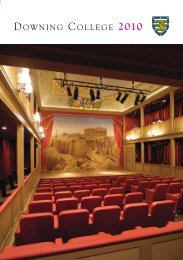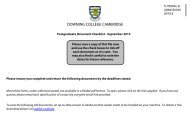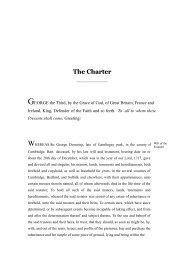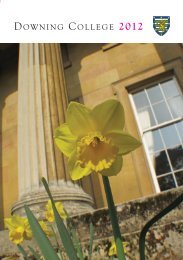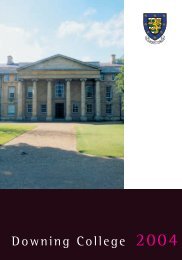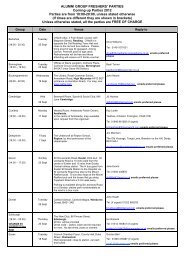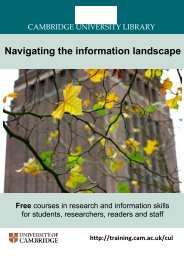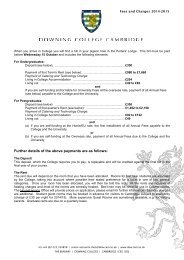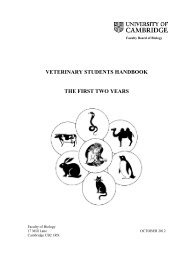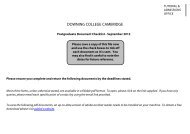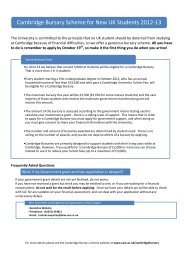at great cost to the <strong>College</strong>’s eventual resources. After her death in 1778, she inturn passed on her claims to her second husband George Bowyer and her nephewJacob John Whittington, in a spiralling sequence <strong>of</strong> litigation. From the 1770s,the prime mover in favour <strong>of</strong> the <strong>College</strong>’s foundation had been another distantmember <strong>of</strong> the <strong>Downing</strong> family, Francis Annesley (pronounced ‘Ainsley’ bycontemporaries; 1734–1812), who, as an heir-at-law to Sir George by femaledescent, could be held to exercise responsibility for the fulfilment <strong>of</strong> histestamentary wishes. Annesley’s victory further extended when, at the passing <strong>of</strong>the Charter in 1800, his efforts were recognized in his confirmation as the<strong>College</strong>’s first Master.Yet it was nearly seven years before building could commence. Though theGoverning Body (here comprising the Master and five founding Fellows) hadcontrol <strong>of</strong> the <strong>Downing</strong> estates, it remained answerable to the Court <strong>of</strong> Chanceryfor its expenditure, with much capital tied up in an increasingly optimisticbuilding fund. The <strong>College</strong> even lacked a satisfactory site. To satisfy legalrequirements for the Charter’s granting, Annesley had purchased a tiny plot calledDoll’s Close, near Jesus <strong>College</strong>, overlooking Midsummer Common, manifestlyunsuitable for the scale he had now come to envisage. An alternative site,Pembroke Leys, had long been suggested as a larger and more fitting location;only with access to the <strong>Downing</strong> resources could this plot be purchased by the<strong>College</strong>, a lengthy process involving the area’s enclosure by an Act <strong>of</strong> Parliament,and not formally agreed by the Master in Chancery until 31st January 1804. Anadditional complication was the vexed question <strong>of</strong> an appropriate architect anddesign for the <strong>College</strong>, part <strong>of</strong> a complex story whose wider importance for thehistory <strong>of</strong> architecture is well known.Schemes <strong>of</strong> various kinds had been solicited since the 1770s, but by 1804–5the Governing Body, subject to the oversight <strong>of</strong> the Court <strong>of</strong> Chancery, wascontemplating the designs <strong>of</strong> no less than five competing architects, <strong>of</strong> varyingcharacter and merit. The contest appears to have been highly factionalized, withthree architects receiving powerful support, <strong>of</strong>fering an intriguing window ontothe interests and affiliations which seem to have shaped the <strong>College</strong>’s earlydecision-making. Crucially, all three supported designs exhibited Neo-Classicism<strong>of</strong> a strongly Greek flavour: the published attack by Thomas Hope (1804) on anearlier scheme by James Wyatt appears to have established some importantaesthetic benchmarks. From around this time, both Annesley and the Pr<strong>of</strong>essor<strong>of</strong> Medicine, Busick Harwood, seem to have favoured the hiring <strong>of</strong> the <strong>College</strong>’seventual architect William Wilkins (1778–1839), having had sight <strong>of</strong> Wilkins’ firstset <strong>of</strong> designs for the <strong>College</strong>, which have unfortunately failed to survive. Thepair are conventionally identified as ‘Graecophils’: these preferences are perhapsbest regarded as expressing a broader range <strong>of</strong> reforming commitments,23
underpinned by shared secular experience, Harwood as a physician, Annesley asa trained, though non-practising, lawyer. Of independent means, Annesley hadfrom 1774 held the parliamentary seat <strong>of</strong> Reading; without party affiliation, hisvoting generally supported Pitt’s government. Both the abandoning <strong>of</strong> Wyatt andthe promotion <strong>of</strong> Wilkins had an important context in the Society <strong>of</strong> Antiquaries,London, <strong>of</strong> which Annesley (1759) and Harwood (1783) were long-standingFellows. In the 1790s Wyatt had aroused criticism over his ‘restoration’ <strong>of</strong> severalcathedrals, for which he and several <strong>of</strong> his pupils were blackballed. 2 One victimwas William Porden, another would-be architect <strong>of</strong> <strong>Downing</strong>, whose startlingGothic design for the <strong>College</strong> may be best regarded as a sophisticated lampoon.The successful election <strong>of</strong> Wilkins to a Fellowship in this same period (1800), lendsfurther significance to his connection with Harwood, listed among his sponsors.Yet Wilkins’ selection was far from inevitable. For a significant period in theprocess the more likely candidate had been George Byfield (c.1756–1813), a moremodest practitioner <strong>of</strong> Neo-Greek architecture, and at the time involved in theconstruction <strong>of</strong> several gaols, including that in Cambridge (1802–7). Byfield’s l<strong>of</strong>tyelevation owed much to an alternative network <strong>of</strong> patronage centring onPhilip Yorke <strong>of</strong> Wimpole Hall, 3rd Earl <strong>of</strong> Hardwicke (1757–1834), a majorCambridgeshire landholder and stout Whig, whose family had long exercisedinfluence over the <strong>College</strong>’s destiny. 3 In the 1760s, Philip’s father, Charles Yorke,as <strong>University</strong> MP and government law <strong>of</strong>ficer had played a leading role in pursuingthe <strong>Downing</strong> cause on the <strong>University</strong>’s behalf, efforts halted by his prematuredeath in 1770. Byfield, in addition to his prison work, had undertaken projectsfor Philip’s uncle, the 2nd Earl, also called Philip (1720–90). Byfield’s proponentswithin the <strong>College</strong> were also indebted to the 3rd Earl’s patronage. The Pr<strong>of</strong>essor<strong>of</strong> Law, Edward Christian (remarkably the brother <strong>of</strong> Fletcher Christian, leader <strong>of</strong>the mutiny on the Bounty) had also been a counsel for the <strong>Downing</strong> cause andhad advanced almost every step <strong>of</strong> his career through the Yorkes’ protection andsupport. Byfield’s other supporter was Dr William Craven, Reader in Arabic, whoas Master <strong>of</strong> St John’s not only had special responsibilities under the <strong>College</strong>’sCharter, but also held a position nominated by the 3rd Earl’s uncle, James Yorke,bishop <strong>of</strong> Ely.The question was further complicated by a third focus for support, in LewisWyatt (c.1788–1853), nephew <strong>of</strong> James Wyatt, whose work Hope had socondemned. The design, in a light Neo-Greek style, was Lewis’ first for a major2. J. Evans, A History <strong>of</strong> the Society <strong>of</strong> Antiquaries (1956), pp. 204–14. I am grateful to the Society’sAssistant Librarian, Adrian James, for supplying some further details <strong>of</strong> Fellowship elections.3. Also a Fellow <strong>of</strong> the Society <strong>of</strong> Antiquaries (1791), and patron <strong>of</strong> Sir John Soane; for Philip’seducation and Grand Tour, see P. Searby, A History <strong>of</strong> the <strong>University</strong> <strong>of</strong> Cambridge, III: 1750–1870(1997), 545–61.24
- Page 1 and 2: Downing College 2007
- Page 4: ContentsDowning College Association
- Page 7 and 8: The President. Julian Childs MA
- Page 9 and 10: President’s ForewordThe aim durin
- Page 11 and 12: Cufflinks in solid silver£68 plus
- Page 13 and 14: understanding! The music recitals i
- Page 15 and 16: 14Fellowship and students in reside
- Page 17 and 18: e hung! I was also honoured and del
- Page 19 and 20: Development Director’s ReportThe
- Page 21 and 22: ‘Smaller’ building tasks includ
- Page 23: 1807: The Laying of the Foundation
- Page 27 and 28: the digging out of foundations; the
- Page 29 and 30: Earl to give support to his nephew,
- Page 31 and 32: and other residents. This is the sc
- Page 33 and 34: The Schieffelin Leprosy Research &
- Page 35 and 36: proposed the establishment of a Boa
- Page 37 and 38: DIECI PER TAVOLA GRANDE(Ten for Hig
- Page 39 and 40: sailors’ attempts to steer in a s
- Page 41 and 42: Act 5Scene 1: Near MarchThe final A
- Page 43 and 44: The Literary Larrikin (biography) -
- Page 45 and 46: MarriageAndrew Macintosh (2003) mar
- Page 47 and 48: ObituariesStephen Allcock (1952)Ste
- Page 49 and 50: papers and Oral English, examining
- Page 51 and 52: But he hankered after something to
- Page 53 and 54: Claire Louise Cutler, née Morgan,
- Page 55 and 56: John Raynes (1954)We learned from J
- Page 57 and 58: Martin Ward (1957)Martin Ward came
- Page 59 and 60: Editorial acknowledgementsThis publ
- Page 62: Downing College2006 - 200761
- Page 65 and 66: IAN RICHARD JAMES, M.A., M.A. (Warw
- Page 67 and 68: The Wilkins FellowsGODFREY MICHAEL
- Page 69 and 70: James Norman Birch (Fellow Emeritus
- Page 71 and 72: Memorial service for the late Dr St
- Page 73 and 74: 200 Years the Symbiotic Architectur
- Page 75 and 76:
74In contrast, Jefferson was a Pall
- Page 77 and 78:
The consequence was that when Jeffe
- Page 79 and 80:
In December 2006 Ian Roberts was aw
- Page 81 and 82:
Women’s BadmintonThe first team b
- Page 83 and 84:
Semi Final). It was a pleasure to s
- Page 85 and 86:
Music SocietyPresident: Mark Browne
- Page 87 and 88:
competition for the fourth time in
- Page 89 and 90:
Scholarships, prizes and awards 200
- Page 91 and 92:
College prizesArchaeology & Copsey
- Page 93 and 94:
ArchitectureTripos Part IALeung M Y
- Page 95 and 96:
Land Economy Tripos Part IAManji I
- Page 97 and 98:
Natural Sciences Tripos Part IACart
- Page 99 and 100:
Graduate examinationsDiploma in Com
- Page 101 and 102:
LawBailey-Munroe, S JBansal, N KBel
- Page 103 and 104:
Graduate admissions 2006Anglo-Saxon
- Page 105 and 106:
Loizidou, C CLoo, T MMargaronis, S



